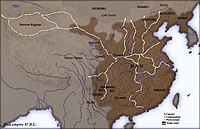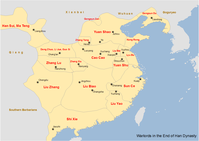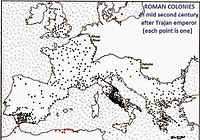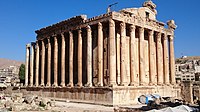Colonies in antiquity
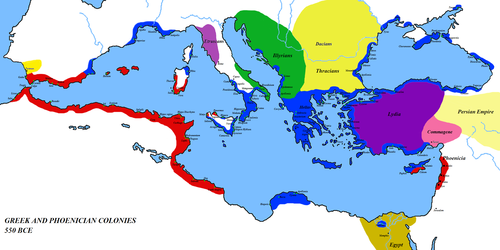
Colonies in antiquity were post-
Sabean Colonization of Africa
One of the oldest colonisation process in history occurred around 1000 BC, the Sabeans of southern Arabia, with a civilization based on agriculture, began to colonize the highlands of northern Ethiopia and Eritrea.[2][3][4][5] The indigenous peoples with whom the Sabaeans came into contact were the ancestors of the contemporary Agaw people. The fusion of southern Arabian culture and Agaw culture resulted in a third culture which are today known as the Habesha people.[6]
Egyptian colonies
Egyptian settlement and colonisation is attested from about 3200 BC onward, all over the area of southern
Phoenician and Carthaginian colonies
The
The most famous and successful of Phoenician colonies was founded by settlers from
According to María Eugenia Aubet, Professor of Archaeology at the Pompeu Fabra University, Barcelona:
The earliest presence of Phoenician material in the West is documented within the precinct of the ancient city of Huelva, Spain... The high proportion of Phoenician pottery among the new material found in 1997 in the Plaza de las Monjas in Huelva argues in favour, not of a few first sporadic contacts in the zone, but of a regular presence of Phoenician people from the start of the ninth century BC. The recent radiocarbon dates from the earliest levels in Carthage situate the founding of this Tyrian colony in the years 835–800 cal BC, which coincides with the dates handed down by Flavius Josephus and Timeus for the founding of the city.[15]
Ancient Greek colonies

In Ancient Greece, a defeated people would sometimes found a colony, leaving their homes to escape the subjugation of a foreign enemy. Sometimes colonies formed as a result of civil disorder, where the losers in internecine battles left to form a new city elsewhere; sometimes they would form to relieve population pressure and thereby to avoid internal unrest; and also, as a result of ostracism. In most cases, however, colony founders aimed to establish trade relations with foreign countries and to further the wealth of the metropolis. Colonies were established in Ionia and Thrace as early as the 8th century BC.[16]
More than thirty Greek city-states had multiple colonies, dotted all across the Mediterranean world. From the late 9th to the 5th century BC, the most active colony-founding city, Miletus of the Ionian League, spawned more than 60 colonies[17] encompassing the shores of the Black Sea in the east, the Iberian Peninsula in the west, Magna Graecia (southern Italy) and several colonies on the Libyan coast of northern Africa.[18]
Greeks founded two similar types of colony, the apoikía (ἀποικία from ἀπό apó “away from” + οἶκος oîkos “home”, pl. ἀποικίαι apoikiai), an independent city-state, and the emporion (ἐμπόριov, pl. ἐμπόρια emporia), a trading colony.
Greek city-states began to establish colonies between 900

Two new waves of colonists set out from Greece between the Dark Ages and the start of the Archaic Period – the first in the early 8th century BC and the second in the 6th century. Population growth and cramped conditions at home seem an insufficient explanation, while the economic and political dynamics produced by the competition between the frequently leaderless Greek city-states – newly introduced as a concept and striving to expand their spheres of economic influence – better fits as their true incentive. By means of this Greek expansion, the use of coins flourished throughout the Mediterranean Basin.
Influential Greek colonies in the western Mediterranean – many in present-day southern Italy — included Cyme; Rhegion by Chalcis and Zancle (c. 8th century); Syracuse by Corinth and Tenea (c. 734 BC); Naxos by Chalcis (c. 734 BC); Massalia (Marseille, c. 598 BC) and Agathe, shortly after Massalia, by Phocaea; Hyele in Italy and Emporion in Spain by Phocaea and Massalia (c. 540 BC and early 6th century); Antipolis in France by Achaea; Alalia in Corsica by Phocaea and Massalia (c. 545 BC) and Cyrene (Cyrenaica, Libya) by Thera (762/61 and 632/31 BC).[21]
The Greeks also
Cicero remarks on the extensive Greek colonization, noting that "Indeed it seems as if the lands of the barbarians had been bordered round with a Greek sea-coast."[23] Several formulae generally shaped the solemn and sacred occasions when a new colony set forth. If a Greek city decided to send out a colony, the citizenry almost invariably consulted an oracle, such as the Oracle of Delphi, beforehand. Sometimes certain classes of citizens were called upon to take part in the enterprises; sometimes one son was chosen by lot from every house where there were several sons; and strangers expressing a desire to join were admitted. A person of distinction was selected to guide the emigrants and to make the necessary arrangements. It was usual to honor these founders as heroes after their death. Some of the sacred fire was taken from the public hearth in the Prytaneum, from which the fire on the public hearth of the new city was kindled. Just as each individual had his private shrines, so the new community maintained the worship of its chief domestic deities, the colony sending embassies and votive gifts to the mother-city's principal festivals for centuries afterwards.
After the conquests of Macedonia and Alexander the Great, a further number of Hellenistic colonies were founded, ranging from Egypt to India.
Greek colonies in Anatolia
By the 15th century BC, the
Before the invasion from
Relations of colony and metropolis
The relation between colony and mother-city (metropolis) was viewed[by whom?] as one of mutual affection. Differences were resolved peacefully whenever possible, war being seen as a last resort. (Note though that the Peloponnesian War of 431–404 BC broke out partly due to a dispute between Corinth and her colony Corcyra.)
The charter of foundation contained general provisions for the arrangement of the affairs of the colony, and also some special enactments. A colony would usually adopt the constitution of the mother-city, but the new city remained politically independent. The "holy fire" of the metropolis was preserved in a special place to remind people of the common ties. If the colony sent out a fresh colony on its own account, the mother-city was generally consulted, or was at least asked to furnish a leader. Frequently the colonies, declaring their commitment to the various metropolitic alliances formed in the Greek mainland and for religious reasons, would pay tribute in religious centres such as Delphi, Olympia, or Delos.[31]
The cleruchs (κληροῦχοι, klêrouchoi) formed a special class of Greek colonists, each being assigned an individual plot of land (κλῆρος, klêros). The trade factories set up in foreign countries, such as Naucratis in Egypt, were somewhat different from ordinary colonies, with the members retaining the right of domicile in their own homeland and confining themselves to their own quarter in the foreign city.
Roman colonies

It was an old custom in
The duty of leading the colonists and founding the settlement was entrusted to a commission usually consisting of three members. These men continued to stand in the relation of
From the time of the
Chinese colonies
In 37 AD the
Cao Song, an Eastern Han administrator of
See also
Notes
- ISBN 978-0-300-08493-1. Retrieved 24 February 2013.
...at their new location, colonists were expected to retain ties with their metropolis. A colony that sided with its metropolis's enemy in a war, for example was regarded as disloyal...
- ^ The Babylonian and Oriental Record. D. Nutt. 1894. p. 107.
- JSTOR 41622129.
- ^ Aethiopica: International Journal of Ethiopian Studies. Harrassowitz Verlag. 2006. p. 283.
- ISBN 978-0-85255-065-6.
- S2CID 143872194.
- ^ Branislav Anđelković, Southern Canaan as an Egyptian Protodynastic Colony
- ^ Branislav Anđelković, Hegemony for Beginners: Egyptian Activity in the Southern Levant during the Second Half of the Fourth Millennium B.C.
- ^ a b Naomi Porat, "Local Industry of Egyptian Pottery in Southern Palestine During the Early Bronze I Period," in Bulletin of the Egyptological, Seminar 8 (1986/1987), pp. 109-129. See also University College London web post, 2000.
- ^ Ancient Egyptian brewery found in downtown Tel Aviv
- ^ Ward, Cheryl. "World's Oldest Planked Boats", in Archaeology (Volume 54, Number 3, May/June 2001). Archaeological Institute of America.
- ^ a b Schuster, Angela M.H. "This Old Boat", Dec. 11, 2000. Archaeological Institute of America.
- ^ Martín Lillo Carpio (1992). Historia de Cartagena: De Qart-Ḥadašt a Carthago Nova / colaboradores: Martín Lillo Carpio ... Ed. Mediterráneo. Retrieved 12 February 2013.
- ISBN 978-1-85043-533-4. Retrieved 8 August 2013.
- ^ Maria Eugenia Aubet (2008). "Political and Economic Implications of the New Phoenician Chronologies" (PDF). Universidad Pompeu Fabra. p. 179. Retrieved 24 February 2013.
- ISBN 978-0-19-956738-6. Retrieved 24 February 2013.
From the 8th century BC the coast of Thrace was colonised by Greeks.
- ^ "Miletus | Ancient Greek City, Turkey, & Map | Britannica".
- ISBN 978-0-19-814260-7. Retrieved 8 August 2013.
- ^ Ancient Greek Colonization and Trade and their Influence on Greek Art | Thematic Essay | Heilbrunn Timeline of Art History | The Metropolitan Museum of Art
- ISBN 978-0-679-76386-4. Retrieved 24 February 2013.
Robin Lane Fox examines the cultural connections made by Euboean adventurers in the 8th century
- ^ A list of Greek colonies with individual articles.
- ^ "About Chersonesos, Sevastopol". National Preserve of Tauric Chersonesos. Retrieved 7 April 2014.
- ^ Cicero, De republica, ii, 9
- ^ "The Greeks". Encyclopædia Britannica. US: Encyclopædia Britannica Inc. 2008. Online Edition.
- ISBN 0-521-83307-8.
- ^ A Short History of Greek Philosophy By John Marshall page 11 “For several centuries prior to the great Persian inversion of Greece, perhaps the very greatest and wealthiest city of the Greek world was Miletus”
- ^ Ancient Greek civilization By David Sansone page 79 “In the seventh and sixth centuries BC the city of Miletus was among the most prosperous and powerful of Greek Poleis.”
- ^ Carl Roebuck, The World of Ancient Times, 1984.
- ISBN 978-0-19-517072-6. "Historical Overview A Greek city-state on the Aegean coast of Asia Minor, at the mouth of Cayster River (Küçük Menderes), Ephesus ..."
- ISBN 978-81-269-0775-5.
- ^ "Ancient Greek colonies | 5.97 | Maria Daniels". Perseus.tufts.edu. Retrieved 2009-05-05.
- Harpers Dictionary of Classical Antiquities(1898)
- ISBN 978-0-472-11534-1.
- ISBN 978-0-521-77064-4.
- ISBN 978-0-521-24327-8.
- ^ Pai, Hyung Il. "Culture Contact and Culture Change: The Korean Peninsula and Its Relations with the Han Dynasty Commandery of Lelang," in World Archaeology, Vol. 23, No. 3, Archaeology of Empires (February 1992): 306-319 [pp. 310–315].
- ISBN 9004156054.
- ^ ISBN 9004156054.
- ISBN 9004156054.
- ISBN 9004156054.
- ISBN 9004156054.
- ISBN 9004156054.
Further reading
- Antonaccio, Carla M. 2001. "Ethnicity and colonization." In Ancient perceptions of Greek ethnicity. Edited by Irad Malkin, 113–57. Cambridge, MA: Harvard University Press.
- ————. 2003. "Hybridity and the cultures within Greek culture." In The cultures within ancient Greek culture: Contact, conflict, collaboration. Edited by Carol Dougherty and Leslie Kurke, 57–74. Cambridge, UK: Cambridge University Press.
- Aubet, Maria Eugenia. 2001. The Phoenicians and the west: Politics, colonies and trade. 2nd ed. Translated by Mary Turton. New York: Cambridge University Press.
- Boardman, John. 1999. The Greeks Overseas: Their Early Colonies and Trade. 4th ed. London: Thames and Hudson.
- ————. 2001. "Aspects of 'colonization.'" Bulletin of the American Schools of Oriental Research 322: 33–42.
- Branigan, Keith. 1981. "Minoan colonialism." Annual of the British School at Athens 76: 23–33.
- Broadhead, William. 2007. "Colonization, land distribution, and veteran settlement." In A companion to the Roman army. Edited by Paul Erdkamp, 148–63. Blackwell Companions to the Ancient World. Malden, MA: Blackwell.
- Cornell, Timothy J. 1995. The beginnings of Rome: Italy and Rome from the Bronze Age to the Punic Wars (c. 1000–264 BC). Routledge History of the Ancient World. New York: Routledge.
- Demetriou, Denise. 2012. Negotiating identity in the ancient Mediterranean. Cambridge, UK: Cambridge University Press.
- Donnellan, Lieve, Valentino Nizzo, and Gert-Jan Burgers, eds. 2016. Conceptualizing early colonisation. Brussels: Belgisch Historisch Instituut te Rome.
- Dunbabin T. J. 1948. The Western Greeks. Oxford: Thames & Hudson.
- Forrest, W. G. 1957. "Colonisation and the rise of Delphi." Historia: Zeitschrift für Alte Geschichte 6 (2): 160–75.
- Garland, Robert. 2014. Wandering Greeks: The ancient Greek diaspora from the age of Homer to the death of Alexander the Great. Princeton, NJ: Princeton University Press.
- Graham, A. John. 1983. Colony and mother city in ancient Greece. 2nd ed. Chicago: Ares.
- ————. 2001. Collected Papers On Greek Colonization. Leiden: Brill.
- Hägg, Robin, and Nanno Marinatos, eds. 1984. The Minoan Thalassocracy: Myth and reality; Proceedings of the third international symposium at the Swedish Institute in Athens, 31 May–5 June 1982. Stockholm: Swedish Institute at Athens.
- Hodos, Tamar. 1999. "Intermarriage in the western Greek colonies." Oxford Journal of Archaeology 18: 61–78.
- Horden, Peregrine, and Nicholas Purcell. 2000. The corrupting sea: A study of Mediterranean history. Oxford: Blackwell.
- Keppie, Lawrence. 1984. "Colonisation and veteran settlement in Italy in the first century A.D." Papers of the British School at Rome 52: 77–114.
- Knappett, Carl, and Irene Nikolakopoulou. 2008. "Colonialism without colonies? A Bronze Age case study from Akrotiri, Thera." Hesperia: The Journal of the American School of Classical Studies at Athens 77 (1): 1–42.
- Malkin, Irad. 1987. Religion and Colonization In Ancient Greece. Leiden: Brill.
- ————. 2011. A Small Greek World: Networks In the Ancient Mediterranean. New York: Oxford University Press.
- Mann, J. C. 1983. Legionary recruitment and veteran settlement during the Principate. Edited by Margaret M. Roxan. London: University of London.
- Niemeyer, Hans-Georg. 1990. "The Phoenicians in the Mediterranean: A non-Greek model for expansion and settlement in antiquity." In Greek colonists and native populations: Proceedings of the First Australian Congress of Classical Archaeology, held in honour of emeritus professor A. D. Trendall. Edited by Jean-Paul Descœudres, 469–89. Oxford: Clarendon.
- Salmon, Edward T. 1936. "Roman colonisation from the Second Punic War to the Gracchi." Journal of Roman Studies 26 (1): 47–67.
- ————. 1955. "Roman expansion and Roman colonization in Italy." Phoenix 9 (2): 63–75.
- ————. 1969. Roman colonization under the Republic. Aspects of Greek and Roman Life. London: Thames and Hudson.
- Stek, Tesse D., and Jeremia Pelgrom, eds. 2014. "Roman Republican colonization: New perspectives from archaeology and ancient history." Papers of the Royal Netherlands Institute in Rome 2014 (62). Rome: Palombi Editori.
- Sweetman, Rebecca J., ed. 2011. Roman colonies in the first century of their foundation. Oxford: Oxbow.
- Ridgway, David. 1992. The first Western Greeks. Cambridge, UK: Cambridge University Press.
- Tartaron, Thomas E. 2013. Maritime networks in the Mycenaean world. Cambridge, UK: Cambridge University Press.
- Tsetskhladze, Gocha R., ed. 2006. Greek Colonisation: An Account of Greek Colonies and Other Settlements Overseas. Leiden: Brill.
- van Dommelen, Peter. 1998. In colonial grounds: A comparative study of colonialism and rural settlement in first millennium BC west central Sardinia. Leiden, The Netherlands: University of Leiden.
External links
- Ancient History Encyclopedia Greek Colonization
- Map of Greek Colonies 9th-6th Centuries BC Archived 2015-09-16 at the Wayback Machine
- The Roman Law Library by Professor Yves Lassard and Alexandr Koptev
- Donald Kagan, Introduction to Ancient Greek History. 6. The Greek "Renaissance" - Colonization and Tyranny (Open Yale Courses)
- A complete catalogue of ancient ports.
- Ancient Greek Colonization and Trade and their Influence on Greek Art-The Metropolitan Museum of Art

